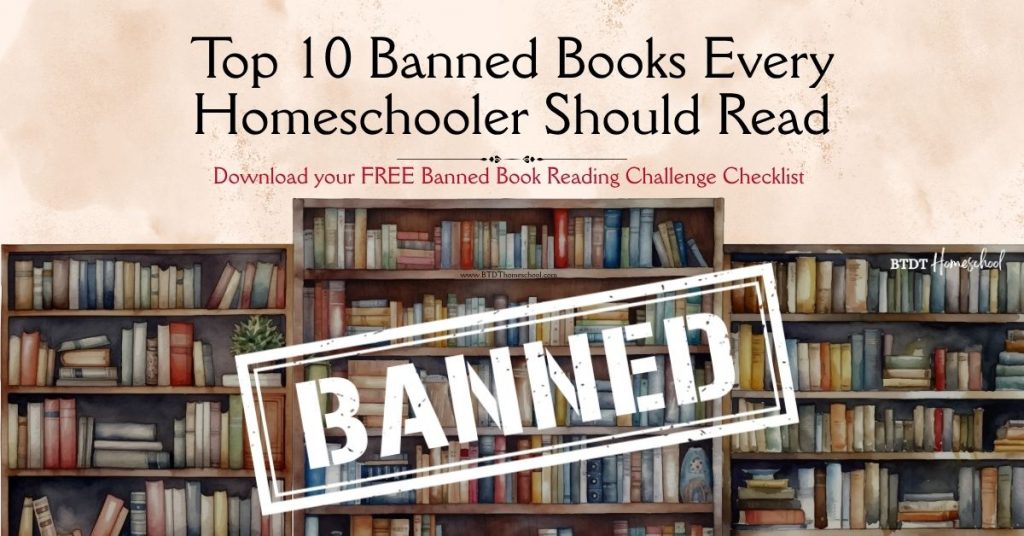Top 10 Banned Books Every Homeschooler Should Read

At BTDT Homeschool, we believe books have the power to shape how children see the world, understand others, and discover who they are. That’s why we never shy away from tough conversations and why we encourage families to read widely, even when a book has been banned or challenged.
Banned Books Week is more than a reminder of censorship. It’s a celebration of stories that make us think, question, grow, and feel deeply. These are the books that challenge assumptions, expand perspectives, and invite meaningful conversations the very heart of a rich education.
We’ve created a free Banned Books Reading Challenge checklist with all our favorites organized by age to make it easier to explore these powerful stories together. Download it, print it, and let it guide meaningful reading and discussion in your homeschool this year.

Here are 10 of our favorite banned or challenged books to explore together as a family. Each one has been questioned, removed, or restricted somewhere, but each also offers something powerful and lasting.
1. To Kill a Mockingbird — Harper Lee
Why we love it: Sitting around the kitchen table reading Scout’s story together led to conversations about fairness, justice, and what it means to stand up for what is right, even when it is hard. Watching our kids connect deeply with Atticus’s quiet courage is something we will never forget. It is one of those stories that grows with them, revealing more layers each time they revisit it.
2. 1984 — George Orwell
Why we love it: This is one of those books that makes teenagers stop scrolling and start thinking. We remember pausing mid-chapter and asking, “What is truth, and who decides it?” It opened their eyes to how language, media, and power shape the world around them. It is intense, but it has sparked some of our most eye-opening family discussions.
3. Fahrenheit 451 — Ray Bradbury
Why we love it: It is impossible to read this without thinking about the world we live in today. When we read it with our teens, we ended up talking late into the night about how important books and ideas really are. The irony that a story about censorship is one of the most banned books always leads to meaningful conversations about why stories matter and why we must protect the freedom to think for ourselves.
4. The Hate U Give — Angie Thomas
Why we love it: This book hit us on a deeply personal level. We read it alongside our teenagers, stopping often to process the emotions and talk about real-world issues like race, justice, and activism. It gave us language to have important conversations about using your voice and standing up for what is right. It is a story that lingers and changes how young people see the world.
5. The Color Purple — Alice Walker
Why we love it: This is a book that made our kids sit in silence after reading. It is heavy, honest, and ultimately hopeful. Through its complex characters and deeply human story, our children learned about resilience, forgiveness, and the strength of the human spirit. It reminded all of us that everyone’s story matters and that people can grow, heal, and change.
6. The Absolutely True Diary of a Part Time Indian — Sherman Alexie
Why we love it: This book made our kids laugh out loud one minute and tear up the next. It is so honest and real about identity, friendship, and finding your path in a world that does not always make it easy. It helped our children see that they are not alone in their struggles and that it is okay to dream bigger than the circumstances you are born into.
7. Maus — Art Spiegelman
Why we love it: This is one of the most powerful teaching tools we have ever used in our homeschool. The graphic novel format drew our kids in, but the emotional impact of the story stayed with them long after. Reading Maus together sparked conversations about history and why we must never forget the past. It is one of those rare books that changes how young people understand the world.
8. Brave New World — Aldous Huxley
Why we love it: We love teaching this book because it forces deep questions. Would we choose comfort over freedom? Is happiness worth the cost of individuality? Reading it with your kids will open the door to conversations about technology and ethics. It was incredible to see our kids wrestle with those ideas and come away with their own thoughtful conclusions.
9. The Outsiders — S. E. Hinton
Why we love it: This is often one of the first banned books homeschoolers introduce, and it never fails to resonate. Our kids have seen themselves in the characters. From the loyalty and struggles to the longing to belong. We read this one aloud as a family years ago, and when we revisited it later, our kids found new meaning in the same pages. It is one of those books that grows with them.
10. The Giver — Lois Lowry
Why we love it: This is Maria’s favorite. She first read this as a family read-aloud and ended up talking about it for weeks afterward. The idea of a “perfect” society without memory, pain, or choice opened so many thoughtful conversations about what it means to be human. It helped our children see that freedom, even when it is messy, is always worth protecting.
Why Reading Banned Books Matters
Banning a book does not erase its message. It only takes away the opportunity to explore and grow. These stories helped our children develop empathy, think critically, and engage with perspectives beyond their own. Stories are not dangerous. But silencing them is!
Want more ideas? Download our Free Banned Books Reading Challenge Checklist to discover age-appropriate books for your family, track your reading, and spark powerful discussions in your homeschool. It’s the perfect companion to keep the learning going long after Banned Books Week is over.





